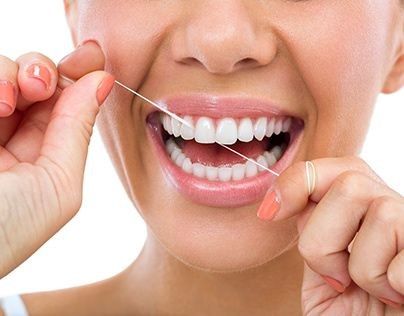Flossing is an important oral hygiene habit and is the act of using thread or ribbon to clean between the teeth. Flossing your teeth cleans and dislodges food stuck between your teeth, which reduces the number of bacteria and plaque in your mouth. Plaque is a sticky film that builds up on teeth and contributes to cavities and gum disease.
Although many people brush their teeth daily, not everyone flosses their teeth as regularly as they brush. The act of flossing our teeth is essential for maintaining healthy teeth and gums. While brushing removes plaque from the top of our teeth, it does not reach underneath the gum line which can cause gingivitis or periodontal disease.
Here are five reasons why you should floss your teeth every day.
1. Flossing is more effective than brushing
Flossing your teeth is just as important as brushing your teeth. Dental floss is designed to reach the tight spaces between the teeth and the gap between the teeth and gums. These are areas that a toothbrush is not able to reach. Dental floss also removes the plaque that builds up near the gum line and between the teeth. A toothbrush cannot completely remove the plaque from the teeth and gums.
2. It avoids gum disease
Cleaning between your teeth helps remove a sticky film called plaque. Plaque contains bacteria that feed on leftover food or sugar in your mouth. When that happens, it releases an acid that can eat away at the outer shell of your teeth and cause cavities.
Therefore, flossing is the most important technique we can do to prevent gum problems. Tiny food particles become lodged in the spaces where the gums and teeth meet. The plaque will harden into tartar and tartar can eventually lead to gingivitis (inflammation of the gums).
If left untreated, gingivitis eventually leads to periodontal disease. Periodontal disease can lead to tooth and bone loss. Regular flossing removes most of the food and plaque that toothbrushes can’t reach.
As a result, cleaning between your teeth may help prevent cavities and gum disease.
3. It prevents tartar buildup.
Plaque that is not removed by brushing and cleaning between your teeth can eventually harden into a rough substance called tartar (or calculus). Tartar collects along your gum line and can lead to gum disease. Once tartar forms, only your dentist can remove it. So, flossing helps to reduce and prevent tartar buildup.
4. It protects you from disease
Good dental hygiene protects more than your teeth and gums. Research shows that when bacteria flourish in an unhealthy mouth, it can lead to several serious health problems and diseases. The list includes heart disease, respiratory disease, and diabetes.
5. Saves your money
Flossing plays an essential role in maintaining healthy teeth and gums. Good dental health also requires regular teeth cleaning and dental checkups as well. The benefits of regular flossing, however, will greatly reduce the amount of money you spend on dental care in the long run.
The best time to floss your teeth:
The most important thing about cleaning between your teeth is to do it. As long as you do a thorough job, it doesn’t matter when. Pick a time of day when you can devote an extra couple of minutes to your dental care. People who are too tired at the end of the day may benefit from cleaning their teeth first thing in the morning or after lunch. Others might like to go to bed with a clean mouth.
Knowing the right time to floss also contributes to good oral health. Some people have a routine of brushing their teeth first and then flossing. However, it’s generally recommended to floss and then brush your teeth.
Flossing helps lift and release food and plaque stuck in between your teeth while brushing removes these particles from your mouth. If you brush first and floss afterward, food and plaque remain in your mouth until the next time you brush. Also, the American Dental Association recommends flossing at least once per day and brushing twice per day.
Types of dental floss
Dental floss comes in many varieties. Which type of floss is best for you depends on your preferences, the amount of space in between your teeth, and whether you have braces or bridges.
Some dental floss is easier to use in wider spaces, whereas other types of floss are easier to use in tighter spaces.
Different types of dental floss include:
- Dental tape. This type of dental floss is broader and flat like a ribbon, making it easier to handle if you have braces, gaps, or large spaces in between your teeth.
- Standard floss. This is a thin, nylon strand that can fit in between teeth. It comes flavored or unflavored as well as waxed or unwaxed. If your teeth are crowded or closer together, dental floss with a wax coating can make it easier to get in between them.
- Super flosses. This dental floss threader can work with braces, bridges, and gaps. It has three components: a stiffened end for flossing underneath appliances, spongy floss to clean around your appliances, and regular floss to eliminate plaque underneath your gum line.
How to floss your teeth properly:
Use this step-by-step guide to find out how to properly floss your teeth:
1. Break off about 18 inches of floss and wind most of it around one of your middle fingers. Wind the remaining floss around the same finger of the opposite hand. This finger will take up the floss as it becomes dirty.

2. Hold the floss tightly between your thumbs and forefingers.

3. Guide the floss between your teeth using a gentle rubbing motion. Never snap the floss into the gums.

4. When the floss reaches the gum line, curve it into a C shape against one tooth. Gently slide it into the space between the gum and the tooth.

5. Hold the floss tightly against the tooth. Gently rub the side of the tooth, moving the floss away from the gum with up and down motions.
6. Move to a new section of floss for each tooth. Shift your fingers down the floss so that the section between them is fresh. When you’ve used the entire section of exposed floss, unwind some fresh floss from around your middle fingers. This ensures that you’re flossing with a clean section of floss each time, which helps get your teeth cleaner.

7. Don’t forget the backs of your rear molars. Reach back into your mouth so that you can loop the floss around your rear molars. Work the floss against the back of your teeth to clean them. Be sure to clean the back of your last tooth on each side on both the top and the bottom.
8. Floss your bottom teeth after you finish your top teeth. Like with your top teeth, start in the middle, then do each side. Make sure to do the sides in the same order each time. It’s helpful to mirror the way you flossed your top teeth so that it’s easy to form a habit.
9. Rinse your mouth out with a mouthwash or water when you’re done flossing. After you floss, rinse out your mouth to help remove any stray particles that remain in your mouth. This will also help give your mouth a fresh, clean feeling.
Tips
- You may experience some bleeding in your gums. This is totally normal when you first start flossing and should go away after a few days. If your gums are still bleeding after 3-5 days of consistent flossing, then it’s best to see your dentist make sure your gums are healthy. Nothing is likely wrong, but it’s best to make sure.
- In most cases, your dentist will be able to tell if you’re flossing or not. This is because food particles and plaque will get stuck between your teeth, which may lead to dental problems.
- If you have braces, bridges, or other such items in your mouth, ask your dentist or orthodontist for instructions on brushing and flossing them properly.
- Wash your hands before and after flossing your teeth.
- Keep in mind that cleaning between your teeth should not be painful. If you do it too hard, you could damage the tissue between your teeth. If you’re too gentle, you might not be getting the food out. It’s normal to feel some discomfort when you first start but don’t give up. With daily brushing and cleaning between your teeth, that discomfort should ease within a week or two. If your pain persists, talk to your dentist.
- Once you’re finished, throw the floss away. A used piece of floss won’t be as effective and could leave bacteria behind in your mouth.
- Talk to your dentist about what types of oral care products will be most effective for you.
To sum up, good oral hygiene involves more than just brushing your teeth. It also involves flossing and knowing how to floss correctly. If you have not yet developed a brushing habit, at least floss. Even if it is difficult for you to floss your whole mouth, start with a few teeth. Step by step, make brushing and flossing a part of your daily routine.
Flossing helps remove bacteria, plaque, and food from between your teeth, and it reduces the likelihood of tooth decay and gum disease. Along with regular brushing and flossing, make sure you also schedule regular dental cleanings at least twice a year.

